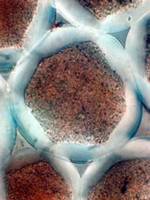
Thank you Roberta Flack!
"We have never before seen a structure like this in the cell walls of plants," says Dr. Rina Kamenetsky. "This is a very rare structure - maybe even unique."
It's known as the ultimate survivor. It grows wild in Israel, thriving in the harsh dry conditions that would kill many other plants. And what do the cells of this hardy survivor - a native Israeli Persian buttercup - look like under a microscope? A Star of David. "It really is symbolic," says Dr. Rina Kamenetsky, a researcher at Israel's Volcani Institute, who made the surprising discovery while trying to understand the survival mechanisms of this resilient bulb, known in Hebrew as nurit, and in Latin as Ranunculus asiaticus. The flower from the Holy Land is also known in botanical circles as a type of 'resurrection plant' which, explains Kamenetsky, means that it can live without water, and is 'resurrected' when water becomes available. Kamenetsky brought samples of the native Israeli type of this Mediterranean species to study during a sabbatical leave at the University of Guelph in Canada last year. She and her Canadian colleagues discovered that the storage roots of this particular Persian buttercup have a special mechanism for resisting drought and heat that is found in no other plant to date - a finding they published recently in the journal New Phytologist. But Kamenetsky also found an additional surprise: under a microscope the cells of the root assume the form of interlocking Stars of David. "When my Canadian colleague Professor Larry Peterson saw it, he called me over right away and said: 'Look, Rina: here's something especially for you.' I was truly amazed," she told ISRAEL21c. It was the first time that Kamenetsky, a leading floriculturist, had seen a Star of David pattern on the cells of any plant. It turns out that the cell walls of the storage roots of this particular plant serve as a shield. In winter, when the first rain comes, the cell walls block the sudden influx of water which could cause the cells to burst. At the same time, they protect the cells from dehydration by absorbing water. The cell walls that serve as a year-round shield also happen to look like a shield - the shield of David. "We have never before seen a structure like this in the cell walls of plants," she says. "This is a very rare structure - maybe even unique." Kamenetsky heads the Volcani Institute's Department of Ornamental Horticulture - part of the research arm of the Israel Ministry of Agriculture responsible for planning, organizing and implementing the greater part of Israel's agricultural research effort. She's now planning collaboration with researchers from France, Italy and South Africa to understand the unique survival mechanism of the Israeli varieties of the Persian buttercup. The most common wild type is a red, five-petaled flower with a black center which bears some resemblance to an anemone. In summer, its roots are exposed to the scorching heat - up to 60 degrees centigrade - of the desert earth. The cultivated type - sold commercially as bulbs - has multiple layers of petals and comes in a variety of colors, including white, yellow, pink, red and magenta. Both wild and cultivated types have the same unusual survival mechanism, says Kamenetsky. "The value of this research is that if we can understand these mechanisms, we can endow other plants with these abilities - something that is of growing importance in a world undergoing desertification," she explains. Kamenetsky notes that there are various heat- and drought-resistant plants growing in Africa, all of which have a special mechanism in their leaves. But this is the first time that scientists have ever encountered a drought-resistant mechanism in the roots of a plant. "When I lecture about this research, I call it: 'How to cope with stressful life in Israel.' It could be that when it comes to survival, our own Nurit has something to teach the plants of the world." Kamenetsky, who was born in Kazakhstan, immigrated to Israel in 1990 and has since made an international name for herself in the field of ornamental horticulture - developing native plants into ornamental crops which can be grown commercially and sold as cut flowers or potted plants. Israel is at the cutting edge of this field. Some 20-40 percent of the flowers Israel markets every year are new varieties, notes Kamenetsky, adding that no other country but Holland has such a high percentage of novel varieties. Kamenetsky is also one of the world's leading experts on the Allium (garlic) species which can be grown as ornamental flowers and is being widely studied for its medicinal properties.
No comments:
Post a Comment